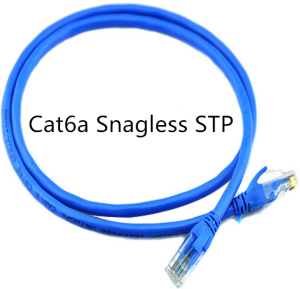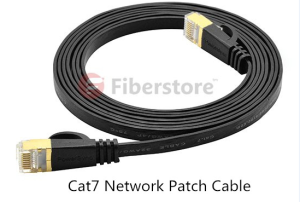When selecting the appropriate network cable categories to support your network, note that there are different grades within each Category. A higher grade cable with the proper installation will allow for a higher margin of error, ensuring top performance today and an extra buffer to support future technology. Properly selecting Cat5e, Cat6, Cat6a, Cat7 solutions will optimally support current and future network speed requirements. But which one should you choose among different Ethernet cable types? This text will give you some guidance.
Ethernet Cable Types: Cat5e has Replaced Cat5 Ethernet Cable
 Cat5 cable can support 10/100 Ethernet. That is, Ethernet and Fast Ethernet. However, Cat 5e cable can support Ethernet, Fast Ethernet, and Gigabit Ethernet. Cat5e cable is completely backwards compatible, and can be used in any application in which you would normally use Cat 5 cable. Crosstalk is the electrical interference that results when one wire’s signal affects another wire’s signal. Cat5e cable has been improved over Cat5 cable in this respect, and cross talk has been greatly reduced. We all know that bandwidth is directly related to network support. The greater the bandwidth, the greater the information-carrying capacity in a given period of time. Cat5e cable is rated at 100 MHz, and it is this increased bandwidth (compared to Cat5 cable) that allows it to support Gigabit Ethernet. Since 1G is widely used today, the Cat5e has gradually replaced the Cat5.
Cat5 cable can support 10/100 Ethernet. That is, Ethernet and Fast Ethernet. However, Cat 5e cable can support Ethernet, Fast Ethernet, and Gigabit Ethernet. Cat5e cable is completely backwards compatible, and can be used in any application in which you would normally use Cat 5 cable. Crosstalk is the electrical interference that results when one wire’s signal affects another wire’s signal. Cat5e cable has been improved over Cat5 cable in this respect, and cross talk has been greatly reduced. We all know that bandwidth is directly related to network support. The greater the bandwidth, the greater the information-carrying capacity in a given period of time. Cat5e cable is rated at 100 MHz, and it is this increased bandwidth (compared to Cat5 cable) that allows it to support Gigabit Ethernet. Since 1G is widely used today, the Cat5e has gradually replaced the Cat5.
Ethernet Cable Types: Choose Cat5e or Cat6 Ethernet Cable?
 Cat6 is a standardized cable for Gigabit Ethernet and other network physical layers that is backward compatible with the Cat5/5e and Cat3 cable standards. Compared with Cat5 and Cat5e, Cat6 features more stringent specifications for crosstalk and system noise. The cable standard provides performance of up to 250 MHz and is suitable for 10BASE-T, 100BASE-TX (Fast Ethernet), 1000BASE-T/1000BASE-TX (Gigabit Ethernet). We may notice that both Cat5e and Cat6 can support Gigabit Ethernet, however, Cat6 is certified for Gigabit networking and will perform better over longer distances. So choosing the Cat6 cable will be more stable to meet the Gigabit needs. But one thing you should keep in mind is that your network is only as fast as your slowest component, so unless every piece of your network (routers, cables, etc.) supports Gigabit Ethernet, you will not be able to reach those speeds.
Cat6 is a standardized cable for Gigabit Ethernet and other network physical layers that is backward compatible with the Cat5/5e and Cat3 cable standards. Compared with Cat5 and Cat5e, Cat6 features more stringent specifications for crosstalk and system noise. The cable standard provides performance of up to 250 MHz and is suitable for 10BASE-T, 100BASE-TX (Fast Ethernet), 1000BASE-T/1000BASE-TX (Gigabit Ethernet). We may notice that both Cat5e and Cat6 can support Gigabit Ethernet, however, Cat6 is certified for Gigabit networking and will perform better over longer distances. So choosing the Cat6 cable will be more stable to meet the Gigabit needs. But one thing you should keep in mind is that your network is only as fast as your slowest component, so unless every piece of your network (routers, cables, etc.) supports Gigabit Ethernet, you will not be able to reach those speeds.
Ethernet Cable Types: Cat6 vs Cat6a Ethernet Cable
 The latest standard from the TIA for enhanced performance standards for twisted pair cable systems was defined in February 2009 in ANSI/TIA-568-C.1. According to this standard, Cat6a is also called Augmented Cat6, which is 10-Gigabit Ethernet over copper proposal to the Cat6 standard. Category 6a performs at improved specifications, in particular in the area of alien crosstalk as compared to Cat6, which exhibited high alien noise in high frequencies. Cat6 specifies cable operating at minimum frequency of 500 MHz—twice that of Cat 6, for both shielded and unshielded. It can support future 10 Gb/s applications up to the maximum distance of 100 meters on a 4-connector channel. Compared with the Cat6, Cat6a is more effective and flexible. As 10G is more and more widely used, Cat6a will become more and more popular.
The latest standard from the TIA for enhanced performance standards for twisted pair cable systems was defined in February 2009 in ANSI/TIA-568-C.1. According to this standard, Cat6a is also called Augmented Cat6, which is 10-Gigabit Ethernet over copper proposal to the Cat6 standard. Category 6a performs at improved specifications, in particular in the area of alien crosstalk as compared to Cat6, which exhibited high alien noise in high frequencies. Cat6 specifies cable operating at minimum frequency of 500 MHz—twice that of Cat 6, for both shielded and unshielded. It can support future 10 Gb/s applications up to the maximum distance of 100 meters on a 4-connector channel. Compared with the Cat6, Cat6a is more effective and flexible. As 10G is more and more widely used, Cat6a will become more and more popular.
Cat7 Will be the Ethernet Cable of Choice
 Cat7 cables are designed to support much higher frequency signals than Cat5e and Cat6. This allows Cat7 cabling to carry a larger amount of information. Cat7 cable is also able to better protect the signals traveling over the cable. The shielding as well as the tighter twists of the pairs in Cat7 cable lessens the effects of crosstalk and EMI. Cat7 cable is commonly terminated using a GG45 connector, which is a connector that it backwards compatible with the 8p8c RJ45 connectors used on Cat6 or Cat5e cable. The GG45 connector has four additional conductors that provide support for frequencies of up to 600MHz. The higher frequencies allow Cat 7 cable to support 10-Gigabit Ethernet. Currently, Cat7 is not widely adopted. Cat5e and Cat6 solutions sufficiently support the bandwidth requirements of today’s data centers, networks, and end users. Using Cat7 for a connection to a desktop would be unnecessary because the bandwidth would not be utilized. It may also be an unnecessary expense for many data center applications for the same reason. However, as technology advances and requirements increase, Cat7 cable will become more relevant in the data center and desktop connections.
Cat7 cables are designed to support much higher frequency signals than Cat5e and Cat6. This allows Cat7 cabling to carry a larger amount of information. Cat7 cable is also able to better protect the signals traveling over the cable. The shielding as well as the tighter twists of the pairs in Cat7 cable lessens the effects of crosstalk and EMI. Cat7 cable is commonly terminated using a GG45 connector, which is a connector that it backwards compatible with the 8p8c RJ45 connectors used on Cat6 or Cat5e cable. The GG45 connector has four additional conductors that provide support for frequencies of up to 600MHz. The higher frequencies allow Cat 7 cable to support 10-Gigabit Ethernet. Currently, Cat7 is not widely adopted. Cat5e and Cat6 solutions sufficiently support the bandwidth requirements of today’s data centers, networks, and end users. Using Cat7 for a connection to a desktop would be unnecessary because the bandwidth would not be utilized. It may also be an unnecessary expense for many data center applications for the same reason. However, as technology advances and requirements increase, Cat7 cable will become more relevant in the data center and desktop connections.
Comparison of Different Ethernet Cable Types
Some specifications for Cat5, Cat6, Cat7 are introduced above, then I will show you a table. From the table below, you can see their differences more clearly:

Related Articles:
Difference of Straight Through and Crossover Cable
Patch Cable vs.Crossover Cable: What Is the Difference?
Quick View of Ethernet Cables Cat5, Cat5e And Cat6




